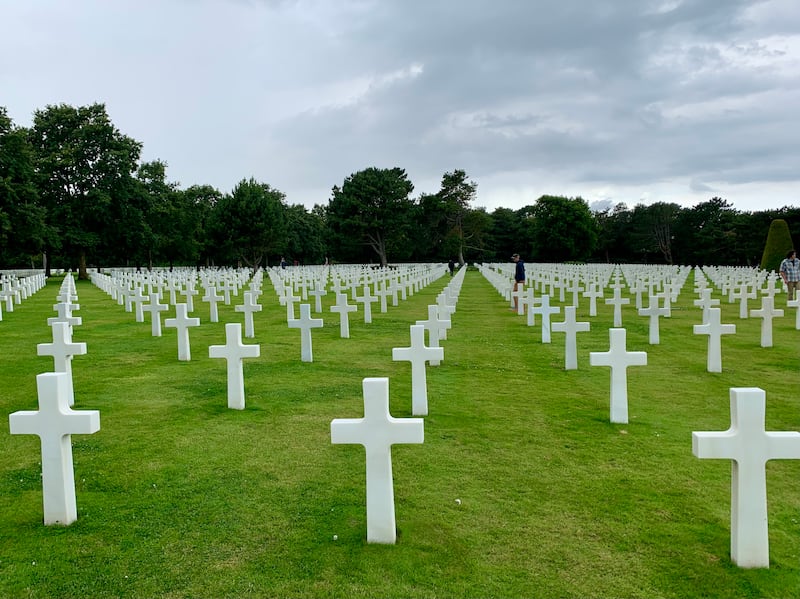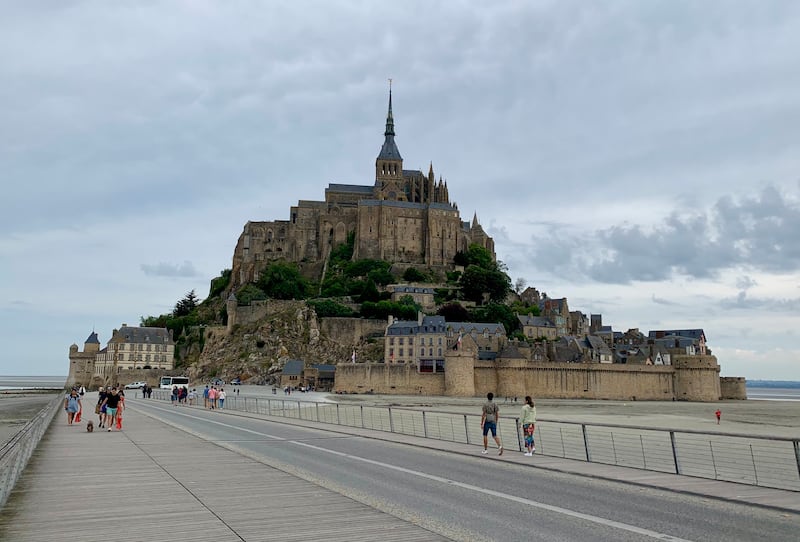French was my favourite subject at school. Each September we’d get a new edition of a French book called Hexagon and I’d take myself off to bed for hours reading up on escargots and boules, stripy-top wearing cyclists and Johnny Hallyday’s musical output in the 80s. France seemed like the antithesis of Ireland, everything on these illustrated pages seemed so sophisticated, glamorous and cool. I wanted in.
When I was 15 I begged my parents to allow me to go on a language exchange to Brittany. It was my first time leaving the country and the trip was one of the highlights of my childhood. The Mont Saint-Michel was summited, the TGV whisked us to Paris for further summiting of Sacré Coeur and the Eiffel Tower. I swore to myself that this would be my future home but a subsequent three-year degree in French literature poring over endless grammar and 18th-century poetry somehow put a damper on that dream. Other obsessions developed, the world opened up and sadly a life of eating croissants never materialised.
Now I have a 15-year-old son myself, also in the throes of learning the language, and I desperately wanted him to experience some of that French magic I first felt during my own teenage visit. Parisian friends with a similarly aged son were kind enough to invite us to their house in Normandy this summer and we spent a week in the green countryside near Saint Lô.

The Irish Red Cross set up a hospital in this town in 1945 staffed by 100 Irish doctors and nurses including a young ambulance driver named Samuel Beckett. This was neutral Ireland’s only official involvement in the second World War. Ninety-five per cent of Saint Lô was destroyed in the aftermath of D-Day but the town’s reconstruction became a symbol of hope for postwar France. The ramparts miraculously still stand and we walked them every morning imagining life here during the German occupation.
READ MORE
My unshaking belief in Irish neutrality was rattled during these walks and rattled much further as we walked among the 9,389 white marble crosses in the American Cemetery for military who died during the Normandy landings in 1944. Located just above Omaha Beach, the cemetery overlooks the channel that saw the largest seaborne invasion in the history of warfare. Thunder and lightning crackled in the dark sky above the 172-acre site and the heavens opened as we ran for the car park.
A little further down the coast at Arromanches we spent some time at the D-Day Museum entranced by photos of surviving soldiers both back then and now in the winter of their lives. Somehow their stoic faces explained more about the travails of war than any Saving Private Ryan or Band of Brothers could. The remains of a giant floating bridge used to transport Allied supplies into France are still strewn across the beach here. Later on we returned to Omaha Beach for a swim, the tangible weight of history is incredibly present and I feel honoured to have visited this pivotal stretch of coast.
In the coming days we explore the western side of Normandy beginning at beautiful Blainville with views across the oyster beds to the Channel Islands. We have the whole beach almost to ourselves and following a quick swim we are soon eating oysters and mussels harvested from these waters at a cafe right on the sand. La Cale is the most perfectly unfussy beach shack, I would happily have stayed there for the rest of the holiday eating sausages cooked over an open fire and drinking the region’s famed cider and Calvados.

Our French hosts continue their expert tour-guiding by leading us to nearby Coutances to stock up on wine from their caviste or wine merchant (a new word for me and one that I like) and local cheese from a fromagerie in the shadow of the town’s impressive cathedral. Our dream French bingo card is complete when a boules court appears in a nearby square and our friends magically procure a set of chrome balls from their car boot.
A delivery driver from Decathlon waits outside our friends’ house with a giant cardboard box containing a flat-pack table tennis table. The stress of the assembly is soon forgotten as epic battles of le ping pong ensue. I’m instantly transported back to the basement of the house I stayed in during my own exchange all those years ago with memories of awkward teenagers finally bonding over something that needed no common language.
Normandy is incredibly green. Endless fields of corn, wheat and potatoes extend in every direction across the verdant landscape. All this farmland results in multiple tractors holding up progress on our early morning spin to the Mont Saint-Michel. The island’s towering abbey comes into view, its monumental presence on the skyline explains why this has been a place of pilgrimage since the Middle Ages.
A new bridge has been built since my last teenage visit allowing the tide to reclaim the sandbanks that threatened to fill in the causeway permanently. The 40-minute walk across this new wooden structure is a delight and we ascend the snaking streets towards the abbey almost in the absence of other tourists given our early arrival. This is France’s second-most-visited attraction after the Eiffel Tower and the crowds have swollen as we make our way down again.
Sadly, our early start meant that we missed out on the soufflé omelettes at La Mère Poulard, reputedly the most celebrated omelette in the world. The restaurant, at the base of the mount, has been sought out by pilgrims and tourists since the 1880s.
We meet up with our friends for lunch at Granville, a port town an hour up the coast. Au P’tit Mareyeur does not serve omelettes but we make do instead with a seafood feast all sourced from the water just across the road. A bottle of Sancerre had us floating from our outdoor table and up the steps to the Haute Ville (the upper town) where the locals lined the street with tables outside their doors selling bric-a-brac.

Resisting vintage maps and mid-century lamps, we followed the street down the other side of the hill to the beach where a giant rectangular pool was about to emerge from beneath the dropping tide. While waiting for the big reveal we swam out to a brutalist diving tower to ‘compete’ with the local kids throwing somersaults and backflips. Christian Dior grew up in a pink mansion just above this beach and his former home is now a museum celebrating his life and work.
That evening we visited neighbours to watch the Euro final between England and Spain. A projector was set up in the barn and over multiple bottles of cider I resurrected much of my long-forgotten French as the night wore on. Many Parisians gave up their city lives during the pandemic and bought houses in the countryside including the couple who own this farmhouse. As we stroll home in the pitch dark I can understand the attraction.
Nearby Bayeux avoided the destruction of many other Normandy towns following D-Day and we take in the cathedral and the beautiful old town as we make our way to the museum housing the 70-metre-long Bayeux Tapestry. This embroidered masterpiece tells the story of local hero William the Conqueror and his epic defeat of the English in 1066. An audio guide brilliantly explains the context of each image and once again the past becomes very much alive. Halley’s Comet makes an appearance, the Mont Saint-Michel gets a guest slot, a cast of 626 characters provides the action and King Harold meets a sticky end with an arrow in the eye.
As we leave we notice a queue outside Le Moulin de la Galette across the road and before long we’re ordering galettes ourselves, a type of buckwheat pancake native to these parts.

Giverny sits on the far eastern boundary of Normandy. The impressionist master Claude Monet put this tiny hamlet on the map by making it his home for 43 years until his death in 1926. We join the throng of international visitors to view the garden and pond that inspired his famous Water Lilies paintings. Having seen these masterpieces at the Orangerie Museum in Paris last year, it was fascinating to walk through the still-intact landscape that informed them. Monet had a new, larger studio built just to allow him work on these giant canvases and this now houses a gift shop. The artist’s colourful house is so successfully restored that it feels like you might turn a corner and bump into the great man himself at any second.
Our week in the deep countryside of Normandy comes to an end and I feel grateful to have experienced so much of this region that has often been at the crossroads of history. My son’s table tennis skills certainly improved and it was joy to watch him realise that there’s so much more to learning French and absorbing the culture than any textbook can offer. I would lie if I said that I wasn’t drawn to estate agent windows in each town we visited: perhaps there’s still hope for my dream of moving here one day.
Getting there
Irish Ferries sails from Dublin to Cherbourg at the northern tip of Normandy.
Brittany Ferries also sails to Cherbourg from Rosslare.
Normandy-Tourism.org is the official site for the region and it’s a fantastic resource to plan your visit with suggestions for car-free getaways and local accommodation tips.












